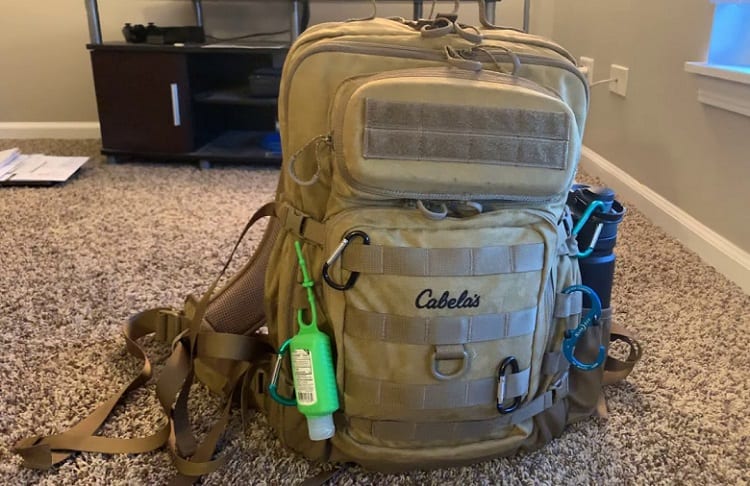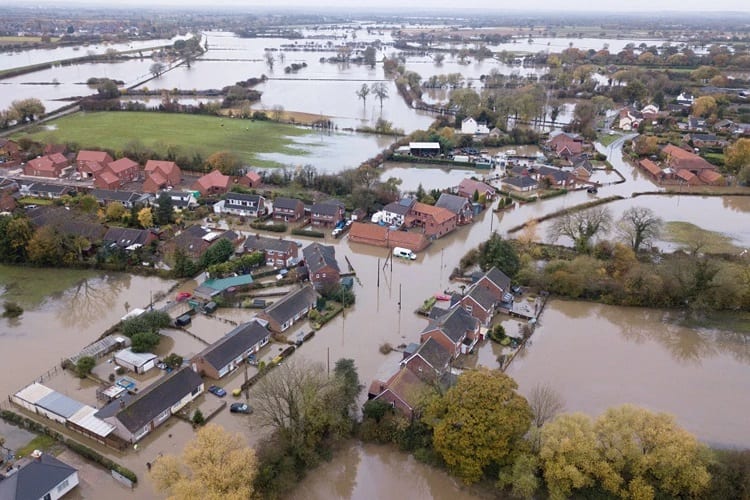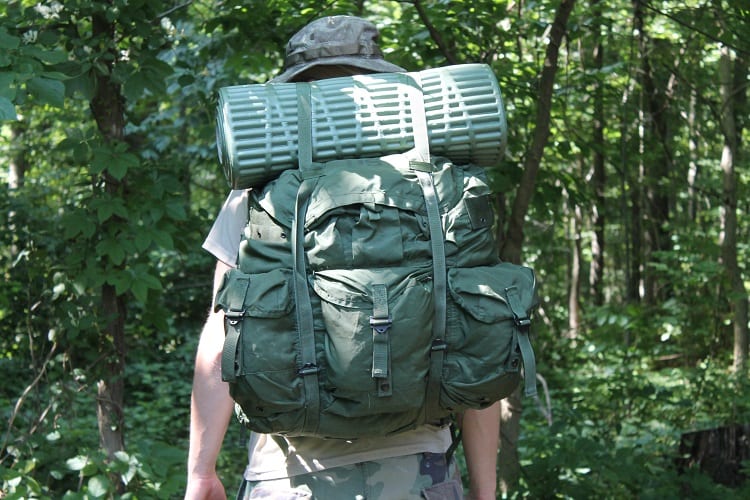Building Your First Bug Out Bag: A Detailed List
Bug out bags are the essential, must-have items for any prepper who understands the stakes and wants to rise above them.
The point is, if you have five minutes (or less) to get your belongings and go, you want to make sure they’re all going to benefit you. A bug out bag is nothing but survival essentials.
This bug out bag checklist has everything you need and explores the possibilities that you’re going to face out in the wilderness during a SHTF situation.
What Is a Bug Out Bag?

A bug out bag is the slang version of a bail-out bag. It’s a backpack with a typically high capacity or volume where you store essential items, food, water, tools, and anything you would ever need in an emergency.
Bug out bags should be assembled with low carry weight in mind, filled with multitools instead of just dedicated tools (when appropriate), and anything that’s critical to survival. If it doesn’t serve a survival purpose or morale purpose, it has to go.
When you bug out, it means leaving your home or place of work, taking a bag with you, and disappearing off the grid. This could be somewhere remote, even a remote home you own in the countryside, or heading into the woods to go all Les Stroud on the wilderness.
What Type of Bag Should You Use?

This is the great debate because there are a lot of great materials and bag designs out there. I’m going to run down some of them, but just know this is not a definitive list that you should ride-or-die by.
Cordura
Cordura is often attached as a prefix to nylon, but it is in fact its own material. Cordura is actually tougher than nylon, which is why the two are often paired together – cost benefits and strength benefits built into one.
With a mostly natural water resistance, it’ll resist most small punctures and abrasions like nothing even happened.
Cotton Canvas
Thin, comfortable, inexpensive cotton canvas comes in many different grades and thicknesses (more on that later). Cotton canvas can be useful for a hybrid blend of strength and comfort in your backpack, not to mention being lightweight.
You’ll find that cotton canvas is usually in backpacks up to 35L, but its appearance begins to wane in larger capacities.
PVC
Waterproof, rip-proof, and durable as they come; PVC is a plastic material that boasts incredible strength and is most commonly used to apply some level of waterproofing or water resistance to backpacks and other pieces of survival gear.
You won’t find backpacks made solely out of PVC, but rather coated to provide an external layer on a different material, such as polyester, to make the ultimate bug out bag.
Polyester
Primarily designed for comfort over strength, polyester may line certain designated pockets in a backpack so that you can secure specific items in there without worrying about them breaking.
Out of all these fabrics, polyester is one of the least durable.
Nylon
Nylon comes in so many different types, but most commonly you will see rip-stop nylon. This durable strand of nylon is interwoven in a grid system to constantly provide strength and tear resistance wherever there is pressure on the bag.
Nylon is used in a lot of durable clothing and weather-resistant clothing as well.
How Big Should it Be?

It depends on who you are and what you are able to handle.
Ideally, you’ll have a 65L backpack stacked to the rafters with everything you need to set up a campsite, fish, hunt, and sleep soundly. Realistically, most people can barely lug a 35L backpack up a one-mile climb before getting winded.
A bug out bag that weighs you down and keeps you behind is going to do a lot more harm than good. This is how to judge what size backpack you should get. Start by asking yourself some questions.
- Do you have any backpacking experience at all?
- Do you exercise? Is your body strong and able to carry dozens of pounds of gear?
- How impressive is your walking/running endurance?
- Have you ever been hiking before?
It’s easy to get wrapped up in what you should bring with you, not what you’re able to bring with you. Take an honest, hard look at yourself, your physical build, and your capabilities, and really do your best to determine if you have the necessary experience.
- 25L backpacks are better suited for get home bags or three-day bug out bags; they range from 2 lbs up to 35 lbs on average
- 35L backpacks are good for week-long bug out bags; they range from about 35 lbs to around 50 lbs on average.
- 45L backpacks are enough for a long-term bug out bag; they range from about 50 lbs to 70 lbs on average.
- 55L and above is where you get into the heavyweight territory. Even if you pack them right, these bags can weigh around 70 lbs up to 110+ lbs.
- Your bug out bag essentials and bag itself’s maximum weight should be no more than 25% of your body weight for the average-sized person.
At a certain point, once you have essentials in your backpack, the size of the bag and its capacity doesn’t matter.
If you can barely carry the thing without throwing out your back, it’s a hindrance; not a benefit to your survival. Balancing carry weight and utility is the most difficult part of assembling your bug out bag.
How Long Will the Emergency Last?

This is impossible to know right now, which is why we need a Jack-of-all-trades answer to this question. We need to be prepared for an emergency to last the rest of our lives.
I know that’s a scary thought, but we don’t know what the future holds, and holding out for anything less than that is just plain foolish.
You should have hunting gear, self-defense items, and the means to make your own tools if you need to on your bug out bag list. Learn how to build a DIY bow and arrow, how to make your own water filters, know how to fish, and every skill you can.
The bug out bag you choose will only carry you so far. You will eventually wear through the items you bring with you, so make sure that whatever you bring can set you up for off-the-grid success in the long term. Anticipate for the longest survival situation period possible, and accept it.
What Should You Put in a Bug Out Bag?
Everything you need, and nothing that you don’t.
Your bug out bag needs to include food, water, first aid, a means to make shelter, and the tools to carry yourself through survival. We’re separating what you need to bring into three different categories, each for varying durations of time.
72-Hour or Short Emergencies

A short emergency doesn’t mean a less severe emergency. Sandstorms, tornadoes, and anything that can cause massive damage and havoc in a short amount of time is labeled as an emergency.
You may have a home to come back to, but if not, you’ll have this lightweight, quick-access survival kit to get out of harm’s way with.
Survival Essentials
What are classified as survival essentials?
Compasses, maps, flashlights for visibility, clothes, and things of that sort. If you can’t survive off the land, navigate, or gather food, then you’re going to have a rough time.
Pack survival essentials to ensure that you have the necessary tools to forage, hunt, and cook your own food should the need arise.
Filling Foods
Protein is filling. Fat is filling. Keep sugar-filled “energy bars” at home and stick to higher protein content food, such as protein bars, beef jerky, and anything compact enough to fit in your backpack that can be snacked on while walking.
Avoid foods that require a lot of preparation in case you have to keep going towards your bug out destination without the option to stop.
Make sure whatever you pack has a long shelf life and that you’re rotating out items that don’t have a longer shelf life often.
Water Filtration
Water is the first thing that you can’t live without. Having a reliable water filter is important, but it’s also important to have a freshwater source to actually make use of this.
There are personal water filters such as LifeStraw, gravity-fed systems to filter through gallons of water in minutes, and other water filtration methods (like this DIY filter that you can make on your own).
Water is essential, so make sure it’s part of your bug out plan. Bring some water with you, but be prepared to have to filter water to survive.
Essential Survival Tools
This is where multi-tools really come out to shine. If a tool serves a singular purpose, that’s called a dedicated tool. These are usually the best tool for the task in question, but if you only pack dedicated tools, your bug out bag is going to be filled to the brim with them.
A multi-tool packs a dozen functions into a single, lightweight tool. They could be survival shovels, plier-based multitools, or anything that hides ulterior functions and isn’t dedicated to just one task.
First-Aid Kit
The third most important thing that could be in any bug out bag is your first aid kit and medical supplies.
Water, food, and then being able to stave off infections (in that order). The power of a simple first aid kit is immeasurable when you consider how fragile the human body actually is.
One difficult thing to grapple with is the idea that you may be the only one who can actually perform first aid in an effective manner. Whether you’re traveling alone or you’re with a party, you need to be able to rely on yourself for first aid.
If you get injured or trapped alone, or someone else gets hurt, you want to be able to rise to the occasion. Consider getting first aid certified from the Red Cross to really hone this necessary survival skill.
Replacement Clothes
Replacement clothes seem like a luxury, but they serve a purpose. You can clean your worn-in clothes while you wear replacements, first of all, but wearing some fresh clothes will go a long way in helping you stay clean and avoid fungal infections.
When you bug out and head into the woods, sweat, nature, and everything else build up on your skin and in your clothing that can impact your health in various ways.
Light Communication Equipment
What I mean by light communication is a pair of walkie-talkies that give you just enough utility to talk to other members of your party within a fifteen-mile radius.
There are some walkies that can boost up to 35+ miles of range, but if you need to communicate with someone, they’re likely to be within a short travel distance from where you are.
Lower ranges and frequencies mean less power consumption, so if you plan on being within a five-mile radius of your party members at all times, you can spend less money on your radios.
As a side note, it would be a good idea to have rechargeable batteries and an inverter to collect solar energy and transfer it into batteries.
Medium-Term Emergencies

A medium-term emergency is anything anticipated to be over three days but under fourteen.
You should include everything from the smaller backpack suggestion with a few additional items inside to help you with self-defense, longer time spent sleeping away from home, and harnessing solar power.
Sleeping Bag
You might be roughing it for quite some time, and if that’s the case, you can’t be sleeping on the hard ground on a blanket for the next few weeks or months. You need some kind of sleeping gear.
Sleeping bags are difficult to decide on because you want to get quality sleep and be on your toes all day, but to have a comfortable sleeping bag, you have to take up a lot of space in your emergency kit, making it much bulkier.
A middle-of-the-road option here is a sleeping mat or sleeping pad, both of which are thinner and easier to store.
MREs
MRE stands for meal, ready-to-eat. These are popularized rations from military applications, utilized by the US Department of Defense to supply nutrition to soldiers all around the world.
The great thing about MREs is that they take ages to expire, and they’re nutrient-based meals while still having a light focus on flavor. You won’t be eating like a king with an MRE, but you will get your full dose of vitamins, minerals, and everything that your body needs to survive.
Communication Equipment
For a medium-length bug out, those minimum distance radios might not cut it. They’re good for short-range communication in your party, but what about contacting others to get status updates on the disaster and chaos that made you leave in the first place?
This is what HAM radios are good for: user-generated and supported radio channels where people report things during natural disasters or global pandemics. There are over three million amateur radio operators out there in the community.
Solar Chargers
Recharging your devices through solar energy is the only low-profile, completely silent way that you really have at your disposal. It’s not a wise idea to bring a generator with you when you bug out.
Solar panels on a solar charger can help charge your items while you walk (if you affix them to your backpack), and prove to be far more useful in SHTF situations where you won’t be hunkering down.
Light Arms
Nothing major, but you should have some form of self-defense in the form of a firearm. If you’re traveling with your family or anyone that you want to protect, it’s a good idea to have a small amount of ammunition and lightweight firearms.
Remember self-defense doesn’t have to be extensive or over-the-top; large carbine rifles will make you look like a threat and may send other non-hostile people into a defensive state.
Pepper spray is also a good self-defense tool to pack.
Long-Term Emergencies Require a Big, Heavy Bag

These are emergencies that will last from two weeks to three months. The harshest part of this is realizing that while the goal is to survive off of most of these supplies for three months, this could be the last emergency that we get to prepare for.
We may just be living off the grid from this point on. Anticipate a survival time without a clear end in sight, pack everything from the two smaller bags, and these additional items.
Heavy Survival Tools (Saws, Axes)
We want to keep our bug out bags as lightweight as possible, but if this is a worst-case, end-of-the-world catastrophe, you’re going to need a quality dedicated tool to help you out.
Hatches, full-sized saws, bowie knives or kukri instead of basic pocket knives, basically anything that can be sharpened and used for years on end. Be sure that you’re familiar with your gear before bringing it with you.
Long Guns or Rifles
If this is going to be a long-term thing, you need the necessary firepower to hunt and to defend yourself. Medium-term disasters only require lightweight weaponry because you have to focus on travel weight as well, but in this instance, you’re going to need everything you can get.
Hunting, intimidation, self-defense; it’s good to have a hunting rifle and/or AR-15 with you in these situations.
Word of the wise: bring the necessary items along with you to clean and maintain your guns for an expected three to five years. Given the fact that you won’t be firing it often, lubrication and oil will take up most of that space.
Full-Sized First Aid Kits
First aid is extremely important no matter how you look at it. Having a large, full-utility first aid kit is going to serve a much better purpose than a lightweight 100-piece kit.
There’s the obvious toss-up between packing light for basic or low-level disasters versus an emergency that has no foreseeable end. A full-sized first aid kit should be designed to last you for years if need be.
There are plenty of pre-made first aid survival kits that you can use, although at this level a lot of preppers will assemble their own.
Look at a basic list of first aid supplies (like this one from the Red Cross) and make your own by purchasing individual items and your own physical storage case.
Consider Bringing Bottled Water
Purifying your own water while you’re bugging out is an absolute must, but for the short-term walk or travel to your bug out location of choice, it could be detrimental to stop.
Depending on the disaster, you could either be tracked or not have the time to escape a natural disaster. Find a way to package at least 64 oz of bottled water, which is the recommended daily serving for the average adult. You can refill the bottles with purified water later on.
Should You Have All Three Prepared?

It can’t hurt. It’s better to be over-prepared than overwhelmed. You can gauge the situation and react accordingly if you have three different bag types on standby.
The only major issue here is that you would have to spend the money on three bags, three survival kits, three separate food storage, you get the idea.
It’s more gear to maintain, more bags to check, and more food to cycle through expiration dates. Is it worth it? It absolutely can be, but it has its associated costs that you have to look out for.
You Can Never Be Too Prepared
It’s safe to say that any of us would rather be over-prepared than underprepared. When disaster strikes and it’s time to bug out, you have to make critical decisions at a moment’s notice. You have to be able to change everything about your life in an instant, and that isn’t easy.
You have your essentials, you have your wits about you, and you have a plan – now it’s time to see how you implement it. Pack your bug out bag like you won’t recognize tomorrow, and pray you never have to use it.


I’ve told people to have a load plan and practice it. You select the items you want to bring and then load them on the vehicle. As you load them you add them to the sketch of your vehicle showing location and number it with a list that says what the number is. If it doesn’t fit the way you want to then back up and make necessary changes, remembering to change them on the sketch and list also. After you get it loaded and secured the way you want it, empty the vehicle completely and try it again going by the sketch and list. If done correctly it should get loaded correctly again. Then unload the vehicle, wait a couple months, and try it again using the sketch and list. If it doesn’t fit right then you need to make changes to your instructions on the load plan to make it more clear.
Prioritize the items and pre-load them into containers if possible. Otherwise have the correct container handy for fast loading of items and then moving to the load area. Have separate load plans for each vehicle and trailer, don’t put them on the same sheet because it will cause problems when everyone is trying to load a different area at the same time. Also, post the load plan where it can be found quickly, like on a clip board hanging by the bug out bags.
Good idea, I like it.
Howard